Unit 9 Management Accounting
VerifiedAdded on 2019/12/03
|21
|5977
|134
Report
AI Summary
This report focuses on management accounting techniques applied to Jeffrey & Son's, a manufacturing company producing 'Exquisite.' It covers cost classification, job cost sheet preparation, cost calculation using different absorption rates (direct labor hours and machine hours), variance analysis (comparing budgeted and actual costs for 1900 units), performance indicators for improvement, cost reduction strategies, and budgeting processes (including production, material purchase, and cash budgets). The report details the purpose and nature of budgeting, compares incremental and zero-based budgeting, and analyzes variances, their causes, and corrective actions. Finally, it discusses responsibility centers within the company and how different departments can use variance information for decision-making.
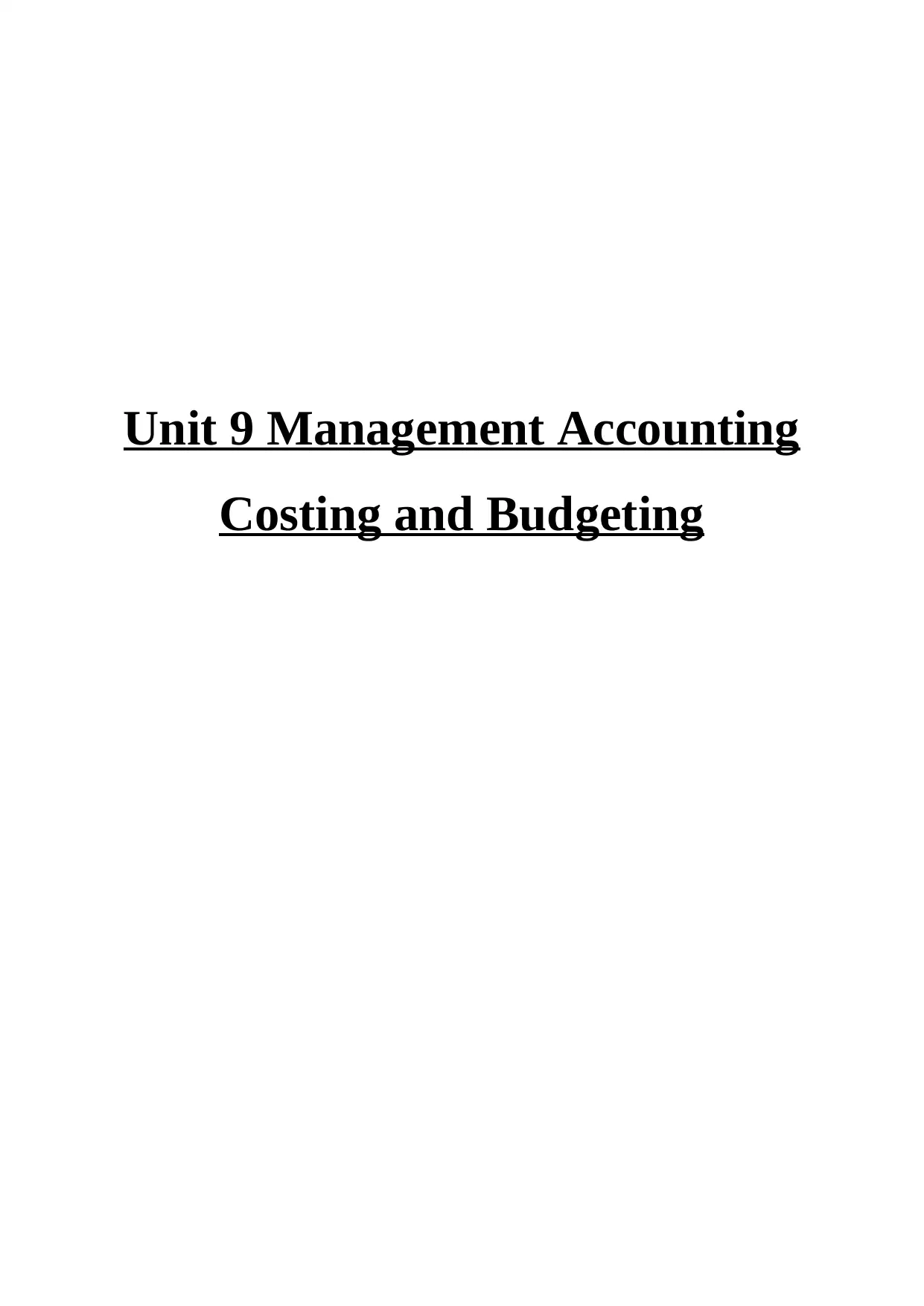
Unit 9 Management Accounting
Costing and Budgeting
Costing and Budgeting
Paraphrase This Document
Need a fresh take? Get an instant paraphrase of this document with our AI Paraphraser
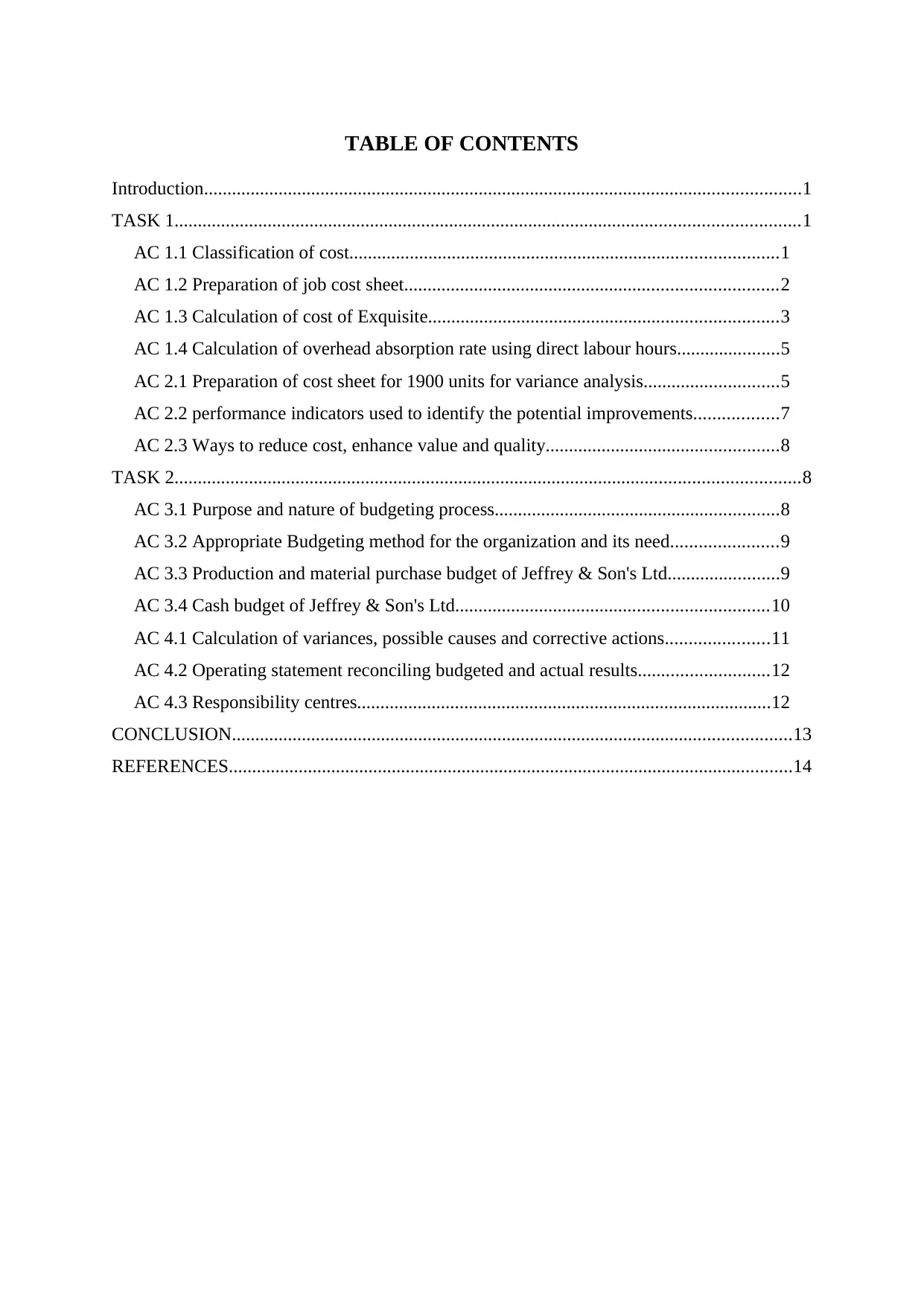
TABLE OF CONTENTS
Introduction................................................................................................................................1
TASK 1......................................................................................................................................1
AC 1.1 Classification of cost............................................................................................1
AC 1.2 Preparation of job cost sheet................................................................................2
AC 1.3 Calculation of cost of Exquisite...........................................................................3
AC 1.4 Calculation of overhead absorption rate using direct labour hours......................5
AC 2.1 Preparation of cost sheet for 1900 units for variance analysis.............................5
AC 2.2 performance indicators used to identify the potential improvements..................7
AC 2.3 Ways to reduce cost, enhance value and quality..................................................8
TASK 2......................................................................................................................................8
AC 3.1 Purpose and nature of budgeting process.............................................................8
AC 3.2 Appropriate Budgeting method for the organization and its need.......................9
AC 3.3 Production and material purchase budget of Jeffrey & Son's Ltd........................9
AC 3.4 Cash budget of Jeffrey & Son's Ltd...................................................................10
AC 4.1 Calculation of variances, possible causes and corrective actions......................11
AC 4.2 Operating statement reconciling budgeted and actual results............................12
AC 4.3 Responsibility centres.........................................................................................12
CONCLUSION........................................................................................................................13
REFERENCES.........................................................................................................................14
Introduction................................................................................................................................1
TASK 1......................................................................................................................................1
AC 1.1 Classification of cost............................................................................................1
AC 1.2 Preparation of job cost sheet................................................................................2
AC 1.3 Calculation of cost of Exquisite...........................................................................3
AC 1.4 Calculation of overhead absorption rate using direct labour hours......................5
AC 2.1 Preparation of cost sheet for 1900 units for variance analysis.............................5
AC 2.2 performance indicators used to identify the potential improvements..................7
AC 2.3 Ways to reduce cost, enhance value and quality..................................................8
TASK 2......................................................................................................................................8
AC 3.1 Purpose and nature of budgeting process.............................................................8
AC 3.2 Appropriate Budgeting method for the organization and its need.......................9
AC 3.3 Production and material purchase budget of Jeffrey & Son's Ltd........................9
AC 3.4 Cash budget of Jeffrey & Son's Ltd...................................................................10
AC 4.1 Calculation of variances, possible causes and corrective actions......................11
AC 4.2 Operating statement reconciling budgeted and actual results............................12
AC 4.3 Responsibility centres.........................................................................................12
CONCLUSION........................................................................................................................13
REFERENCES.........................................................................................................................14
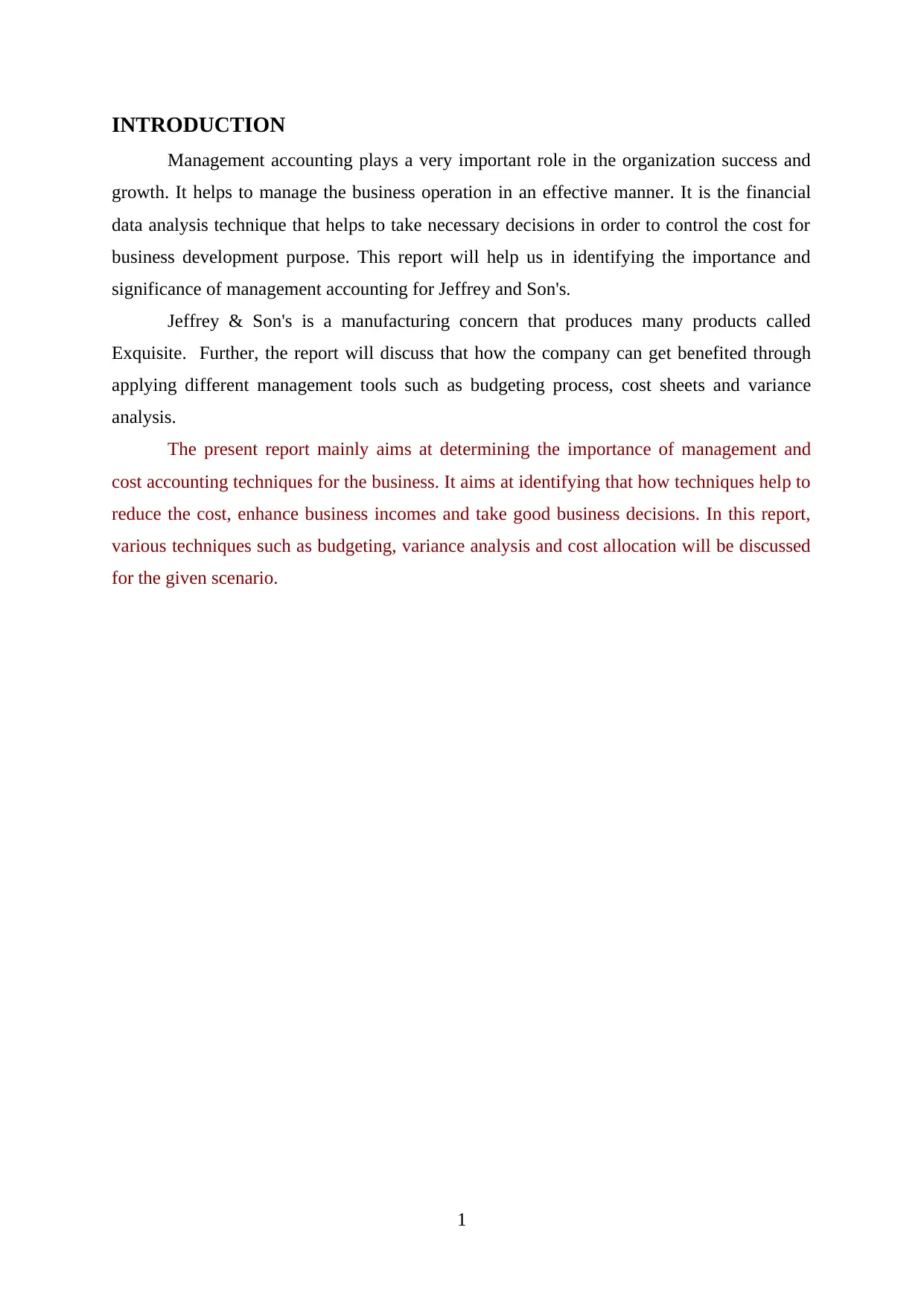
INTRODUCTION
Management accounting plays a very important role in the organization success and
growth. It helps to manage the business operation in an effective manner. It is the financial
data analysis technique that helps to take necessary decisions in order to control the cost for
business development purpose. This report will help us in identifying the importance and
significance of management accounting for Jeffrey and Son's.
Jeffrey & Son's is a manufacturing concern that produces many products called
Exquisite. Further, the report will discuss that how the company can get benefited through
applying different management tools such as budgeting process, cost sheets and variance
analysis.
The present report mainly aims at determining the importance of management and
cost accounting techniques for the business. It aims at identifying that how techniques help to
reduce the cost, enhance business incomes and take good business decisions. In this report,
various techniques such as budgeting, variance analysis and cost allocation will be discussed
for the given scenario.
1
Management accounting plays a very important role in the organization success and
growth. It helps to manage the business operation in an effective manner. It is the financial
data analysis technique that helps to take necessary decisions in order to control the cost for
business development purpose. This report will help us in identifying the importance and
significance of management accounting for Jeffrey and Son's.
Jeffrey & Son's is a manufacturing concern that produces many products called
Exquisite. Further, the report will discuss that how the company can get benefited through
applying different management tools such as budgeting process, cost sheets and variance
analysis.
The present report mainly aims at determining the importance of management and
cost accounting techniques for the business. It aims at identifying that how techniques help to
reduce the cost, enhance business incomes and take good business decisions. In this report,
various techniques such as budgeting, variance analysis and cost allocation will be discussed
for the given scenario.
1
⊘ This is a preview!⊘
Do you want full access?
Subscribe today to unlock all pages.

Trusted by 1+ million students worldwide
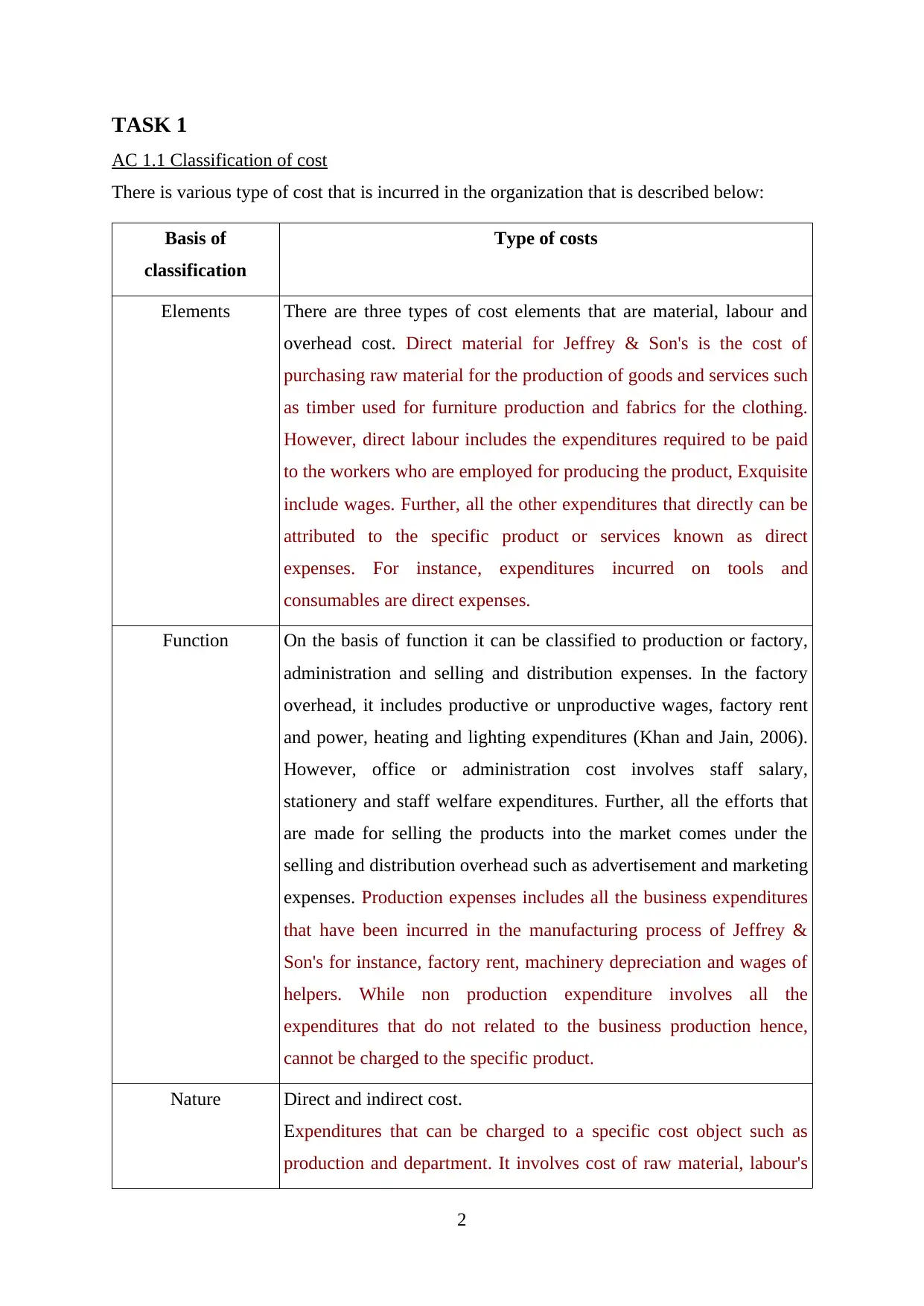
TASK 1
AC 1.1 Classification of cost
There is various type of cost that is incurred in the organization that is described below:
Basis of
classification
Type of costs
Elements There are three types of cost elements that are material, labour and
overhead cost. Direct material for Jeffrey & Son's is the cost of
purchasing raw material for the production of goods and services such
as timber used for furniture production and fabrics for the clothing.
However, direct labour includes the expenditures required to be paid
to the workers who are employed for producing the product, Exquisite
include wages. Further, all the other expenditures that directly can be
attributed to the specific product or services known as direct
expenses. For instance, expenditures incurred on tools and
consumables are direct expenses.
Function On the basis of function it can be classified to production or factory,
administration and selling and distribution expenses. In the factory
overhead, it includes productive or unproductive wages, factory rent
and power, heating and lighting expenditures (Khan and Jain, 2006).
However, office or administration cost involves staff salary,
stationery and staff welfare expenditures. Further, all the efforts that
are made for selling the products into the market comes under the
selling and distribution overhead such as advertisement and marketing
expenses. Production expenses includes all the business expenditures
that have been incurred in the manufacturing process of Jeffrey &
Son's for instance, factory rent, machinery depreciation and wages of
helpers. While non production expenditure involves all the
expenditures that do not related to the business production hence,
cannot be charged to the specific product.
Nature Direct and indirect cost.
Expenditures that can be charged to a specific cost object such as
production and department. It involves cost of raw material, labour's
2
AC 1.1 Classification of cost
There is various type of cost that is incurred in the organization that is described below:
Basis of
classification
Type of costs
Elements There are three types of cost elements that are material, labour and
overhead cost. Direct material for Jeffrey & Son's is the cost of
purchasing raw material for the production of goods and services such
as timber used for furniture production and fabrics for the clothing.
However, direct labour includes the expenditures required to be paid
to the workers who are employed for producing the product, Exquisite
include wages. Further, all the other expenditures that directly can be
attributed to the specific product or services known as direct
expenses. For instance, expenditures incurred on tools and
consumables are direct expenses.
Function On the basis of function it can be classified to production or factory,
administration and selling and distribution expenses. In the factory
overhead, it includes productive or unproductive wages, factory rent
and power, heating and lighting expenditures (Khan and Jain, 2006).
However, office or administration cost involves staff salary,
stationery and staff welfare expenditures. Further, all the efforts that
are made for selling the products into the market comes under the
selling and distribution overhead such as advertisement and marketing
expenses. Production expenses includes all the business expenditures
that have been incurred in the manufacturing process of Jeffrey &
Son's for instance, factory rent, machinery depreciation and wages of
helpers. While non production expenditure involves all the
expenditures that do not related to the business production hence,
cannot be charged to the specific product.
Nature Direct and indirect cost.
Expenditures that can be charged to a specific cost object such as
production and department. It involves cost of raw material, labour's
2
Paraphrase This Document
Need a fresh take? Get an instant paraphrase of this document with our AI Paraphraser
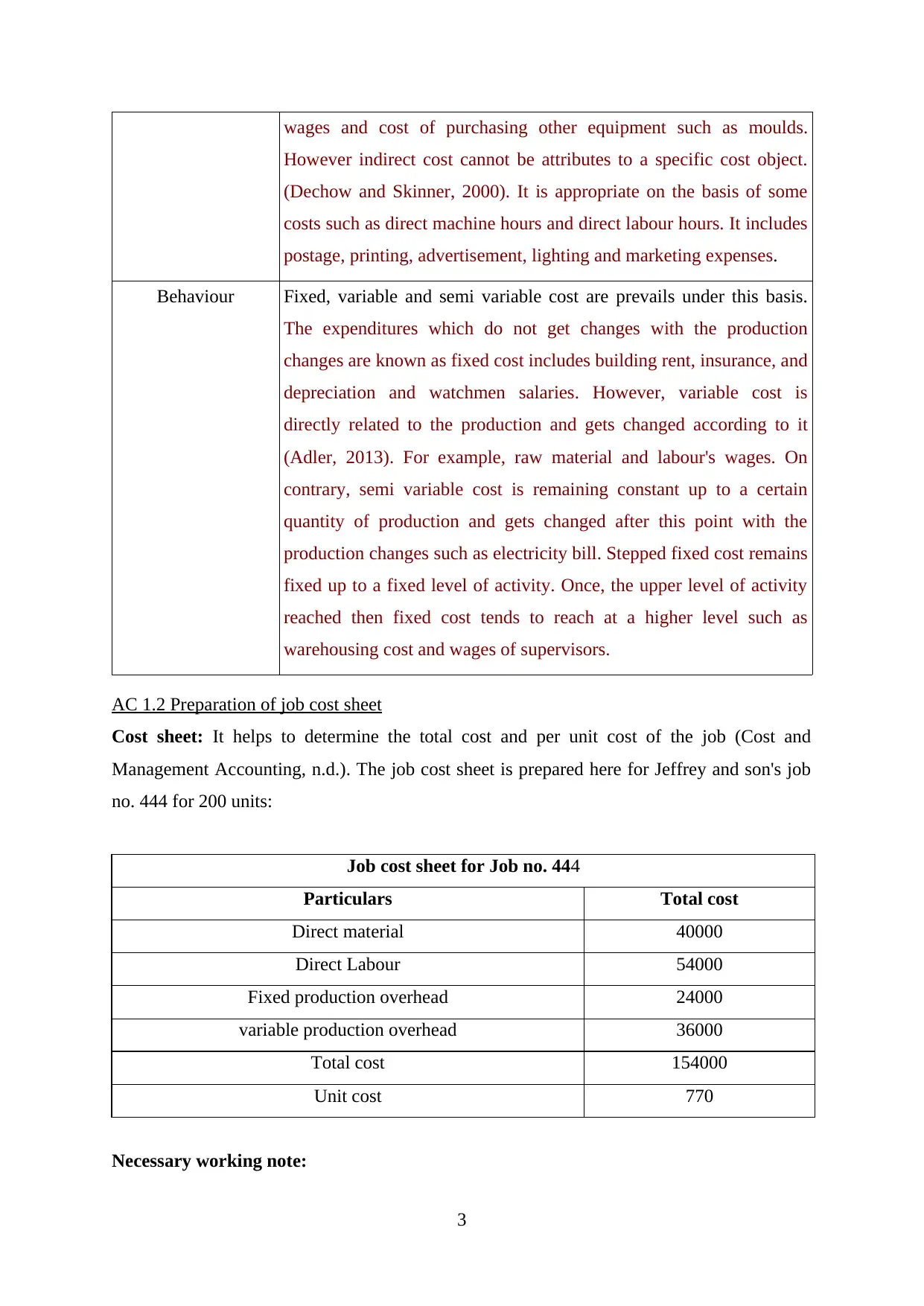
wages and cost of purchasing other equipment such as moulds.
However indirect cost cannot be attributes to a specific cost object.
(Dechow and Skinner, 2000). It is appropriate on the basis of some
costs such as direct machine hours and direct labour hours. It includes
postage, printing, advertisement, lighting and marketing expenses.
Behaviour Fixed, variable and semi variable cost are prevails under this basis.
The expenditures which do not get changes with the production
changes are known as fixed cost includes building rent, insurance, and
depreciation and watchmen salaries. However, variable cost is
directly related to the production and gets changed according to it
(Adler, 2013). For example, raw material and labour's wages. On
contrary, semi variable cost is remaining constant up to a certain
quantity of production and gets changed after this point with the
production changes such as electricity bill. Stepped fixed cost remains
fixed up to a fixed level of activity. Once, the upper level of activity
reached then fixed cost tends to reach at a higher level such as
warehousing cost and wages of supervisors.
AC 1.2 Preparation of job cost sheet
Cost sheet: It helps to determine the total cost and per unit cost of the job (Cost and
Management Accounting, n.d.). The job cost sheet is prepared here for Jeffrey and son's job
no. 444 for 200 units:
Job cost sheet for Job no. 444
Particulars Total cost
Direct material 40000
Direct Labour 54000
Fixed production overhead 24000
variable production overhead 36000
Total cost 154000
Unit cost 770
Necessary working note:
3
However indirect cost cannot be attributes to a specific cost object.
(Dechow and Skinner, 2000). It is appropriate on the basis of some
costs such as direct machine hours and direct labour hours. It includes
postage, printing, advertisement, lighting and marketing expenses.
Behaviour Fixed, variable and semi variable cost are prevails under this basis.
The expenditures which do not get changes with the production
changes are known as fixed cost includes building rent, insurance, and
depreciation and watchmen salaries. However, variable cost is
directly related to the production and gets changed according to it
(Adler, 2013). For example, raw material and labour's wages. On
contrary, semi variable cost is remaining constant up to a certain
quantity of production and gets changed after this point with the
production changes such as electricity bill. Stepped fixed cost remains
fixed up to a fixed level of activity. Once, the upper level of activity
reached then fixed cost tends to reach at a higher level such as
warehousing cost and wages of supervisors.
AC 1.2 Preparation of job cost sheet
Cost sheet: It helps to determine the total cost and per unit cost of the job (Cost and
Management Accounting, n.d.). The job cost sheet is prepared here for Jeffrey and son's job
no. 444 for 200 units:
Job cost sheet for Job no. 444
Particulars Total cost
Direct material 40000
Direct Labour 54000
Fixed production overhead 24000
variable production overhead 36000
Total cost 154000
Unit cost 770
Necessary working note:
3
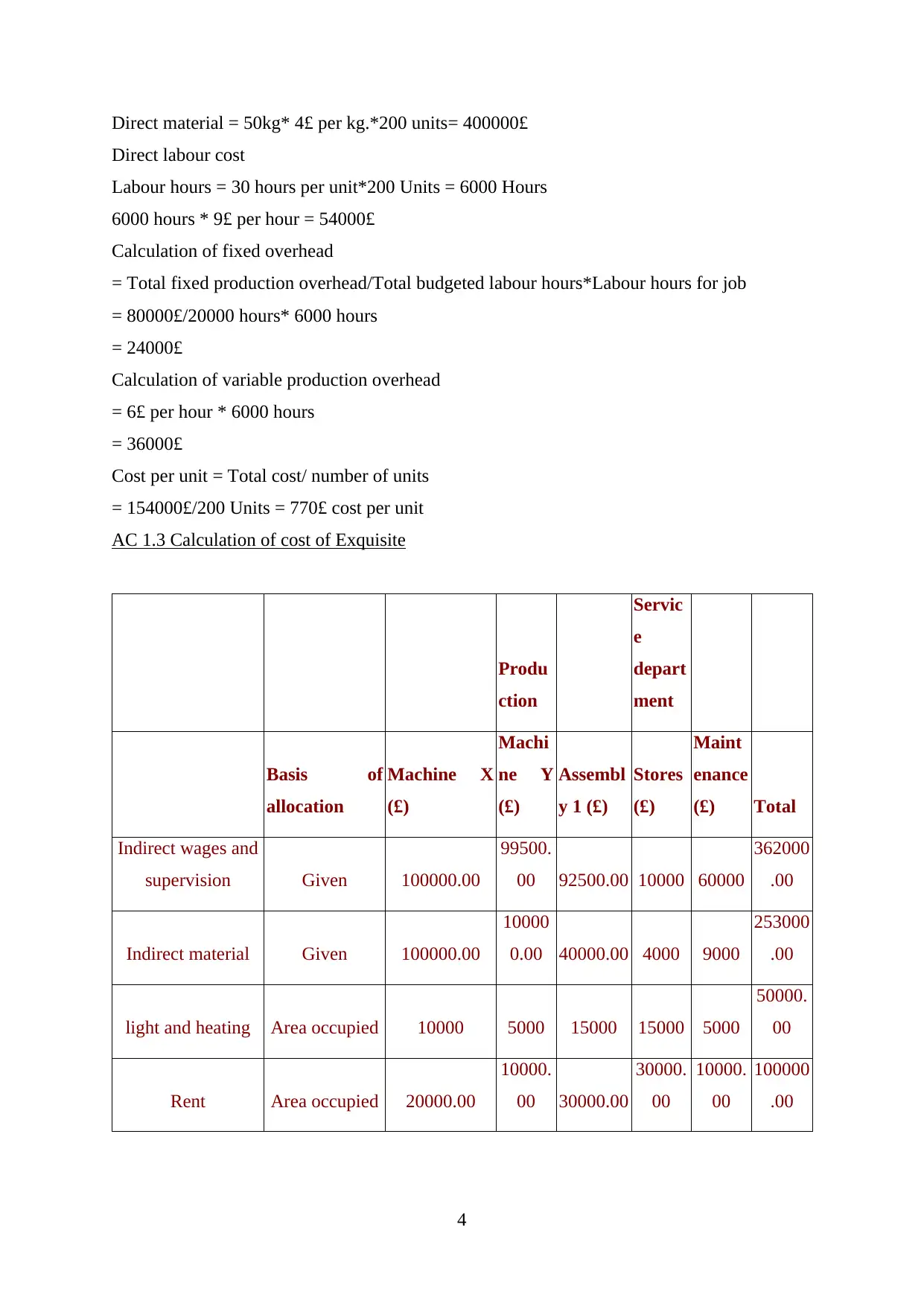
Direct material = 50kg* 4£ per kg.*200 units= 400000£
Direct labour cost
Labour hours = 30 hours per unit*200 Units = 6000 Hours
6000 hours * 9£ per hour = 54000£
Calculation of fixed overhead
= Total fixed production overhead/Total budgeted labour hours*Labour hours for job
= 80000£/20000 hours* 6000 hours
= 24000£
Calculation of variable production overhead
= 6£ per hour * 6000 hours
= 36000£
Cost per unit = Total cost/ number of units
= 154000£/200 Units = 770£ cost per unit
AC 1.3 Calculation of cost of Exquisite
Produ
ction
Servic
e
depart
ment
Basis of
allocation
Machine X
(£)
Machi
ne Y
(£)
Assembl
y 1 (£)
Stores
(£)
Maint
enance
(£) Total
Indirect wages and
supervision Given 100000.00
99500.
00 92500.00 10000 60000
362000
.00
Indirect material Given 100000.00
10000
0.00 40000.00 4000 9000
253000
.00
light and heating Area occupied 10000 5000 15000 15000 5000
50000.
00
Rent Area occupied 20000.00
10000.
00 30000.00
30000.
00
10000.
00
100000
.00
4
Direct labour cost
Labour hours = 30 hours per unit*200 Units = 6000 Hours
6000 hours * 9£ per hour = 54000£
Calculation of fixed overhead
= Total fixed production overhead/Total budgeted labour hours*Labour hours for job
= 80000£/20000 hours* 6000 hours
= 24000£
Calculation of variable production overhead
= 6£ per hour * 6000 hours
= 36000£
Cost per unit = Total cost/ number of units
= 154000£/200 Units = 770£ cost per unit
AC 1.3 Calculation of cost of Exquisite
Produ
ction
Servic
e
depart
ment
Basis of
allocation
Machine X
(£)
Machi
ne Y
(£)
Assembl
y 1 (£)
Stores
(£)
Maint
enance
(£) Total
Indirect wages and
supervision Given 100000.00
99500.
00 92500.00 10000 60000
362000
.00
Indirect material Given 100000.00
10000
0.00 40000.00 4000 9000
253000
.00
light and heating Area occupied 10000 5000 15000 15000 5000
50000.
00
Rent Area occupied 20000.00
10000.
00 30000.00
30000.
00
10000.
00
100000
.00
4
⊘ This is a preview!⊘
Do you want full access?
Subscribe today to unlock all pages.

Trusted by 1+ million students worldwide
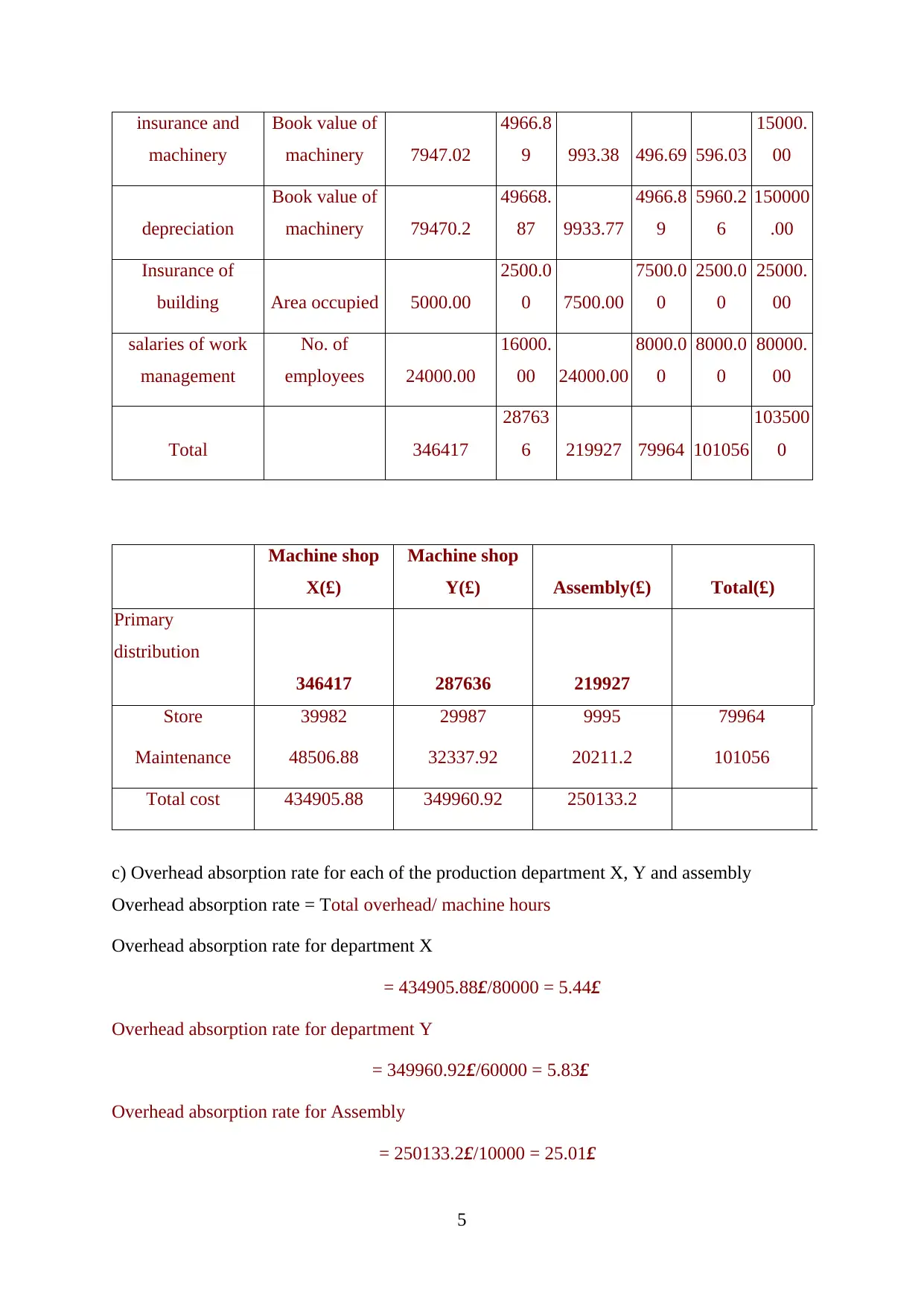
insurance and
machinery
Book value of
machinery 7947.02
4966.8
9 993.38 496.69 596.03
15000.
00
depreciation
Book value of
machinery 79470.2
49668.
87 9933.77
4966.8
9
5960.2
6
150000
.00
Insurance of
building Area occupied 5000.00
2500.0
0 7500.00
7500.0
0
2500.0
0
25000.
00
salaries of work
management
No. of
employees 24000.00
16000.
00 24000.00
8000.0
0
8000.0
0
80000.
00
Total 346417
28763
6 219927 79964 101056
103500
0
Machine shop
X(£)
Machine shop
Y(£) Assembly(£) Total(£)
Primary
distribution
346417 287636 219927
Store 39982 29987 9995 79964
Maintenance 48506.88 32337.92 20211.2 101056
Total cost 434905.88 349960.92 250133.2
c) Overhead absorption rate for each of the production department X, Y and assembly
Overhead absorption rate = Total overhead/ machine hours
Overhead absorption rate for department X
= 434905.88£/80000 = 5.44£
Overhead absorption rate for department Y
= 349960.92£/60000 = 5.83£
Overhead absorption rate for Assembly
= 250133.2£/10000 = 25.01£
5
machinery
Book value of
machinery 7947.02
4966.8
9 993.38 496.69 596.03
15000.
00
depreciation
Book value of
machinery 79470.2
49668.
87 9933.77
4966.8
9
5960.2
6
150000
.00
Insurance of
building Area occupied 5000.00
2500.0
0 7500.00
7500.0
0
2500.0
0
25000.
00
salaries of work
management
No. of
employees 24000.00
16000.
00 24000.00
8000.0
0
8000.0
0
80000.
00
Total 346417
28763
6 219927 79964 101056
103500
0
Machine shop
X(£)
Machine shop
Y(£) Assembly(£) Total(£)
Primary
distribution
346417 287636 219927
Store 39982 29987 9995 79964
Maintenance 48506.88 32337.92 20211.2 101056
Total cost 434905.88 349960.92 250133.2
c) Overhead absorption rate for each of the production department X, Y and assembly
Overhead absorption rate = Total overhead/ machine hours
Overhead absorption rate for department X
= 434905.88£/80000 = 5.44£
Overhead absorption rate for department Y
= 349960.92£/60000 = 5.83£
Overhead absorption rate for Assembly
= 250133.2£/10000 = 25.01£
5
Paraphrase This Document
Need a fresh take? Get an instant paraphrase of this document with our AI Paraphraser
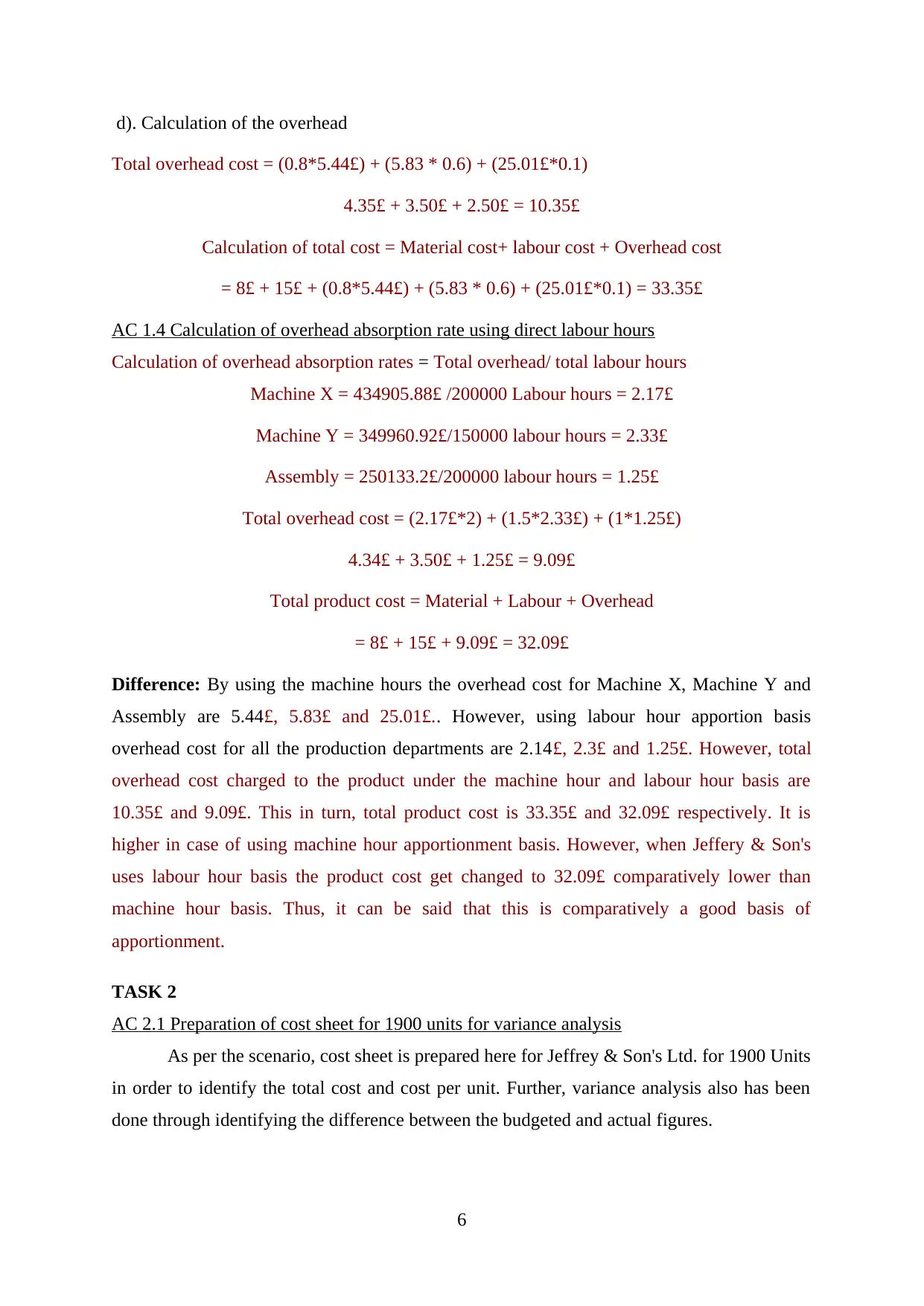
d). Calculation of the overhead
Total overhead cost = (0.8*5.44£) + (5.83 * 0.6) + (25.01£*0.1)
4.35£ + 3.50£ + 2.50£ = 10.35£
Calculation of total cost = Material cost+ labour cost + Overhead cost
= 8£ + 15£ + (0.8*5.44£) + (5.83 * 0.6) + (25.01£*0.1) = 33.35£
AC 1.4 Calculation of overhead absorption rate using direct labour hours
Calculation of overhead absorption rates = Total overhead/ total labour hours
Machine X = 434905.88£ /200000 Labour hours = 2.17£
Machine Y = 349960.92£/150000 labour hours = 2.33£
Assembly = 250133.2£/200000 labour hours = 1.25£
Total overhead cost = (2.17£*2) + (1.5*2.33£) + (1*1.25£)
4.34£ + 3.50£ + 1.25£ = 9.09£
Total product cost = Material + Labour + Overhead
= 8£ + 15£ + 9.09£ = 32.09£
Difference: By using the machine hours the overhead cost for Machine X, Machine Y and
Assembly are 5.44£, 5.83£ and 25.01£.. However, using labour hour apportion basis
overhead cost for all the production departments are 2.14£, 2.3£ and 1.25£. However, total
overhead cost charged to the product under the machine hour and labour hour basis are
10.35£ and 9.09£. This in turn, total product cost is 33.35£ and 32.09£ respectively. It is
higher in case of using machine hour apportionment basis. However, when Jeffery & Son's
uses labour hour basis the product cost get changed to 32.09£ comparatively lower than
machine hour basis. Thus, it can be said that this is comparatively a good basis of
apportionment.
TASK 2
AC 2.1 Preparation of cost sheet for 1900 units for variance analysis
As per the scenario, cost sheet is prepared here for Jeffrey & Son's Ltd. for 1900 Units
in order to identify the total cost and cost per unit. Further, variance analysis also has been
done through identifying the difference between the budgeted and actual figures.
6
Total overhead cost = (0.8*5.44£) + (5.83 * 0.6) + (25.01£*0.1)
4.35£ + 3.50£ + 2.50£ = 10.35£
Calculation of total cost = Material cost+ labour cost + Overhead cost
= 8£ + 15£ + (0.8*5.44£) + (5.83 * 0.6) + (25.01£*0.1) = 33.35£
AC 1.4 Calculation of overhead absorption rate using direct labour hours
Calculation of overhead absorption rates = Total overhead/ total labour hours
Machine X = 434905.88£ /200000 Labour hours = 2.17£
Machine Y = 349960.92£/150000 labour hours = 2.33£
Assembly = 250133.2£/200000 labour hours = 1.25£
Total overhead cost = (2.17£*2) + (1.5*2.33£) + (1*1.25£)
4.34£ + 3.50£ + 1.25£ = 9.09£
Total product cost = Material + Labour + Overhead
= 8£ + 15£ + 9.09£ = 32.09£
Difference: By using the machine hours the overhead cost for Machine X, Machine Y and
Assembly are 5.44£, 5.83£ and 25.01£.. However, using labour hour apportion basis
overhead cost for all the production departments are 2.14£, 2.3£ and 1.25£. However, total
overhead cost charged to the product under the machine hour and labour hour basis are
10.35£ and 9.09£. This in turn, total product cost is 33.35£ and 32.09£ respectively. It is
higher in case of using machine hour apportionment basis. However, when Jeffery & Son's
uses labour hour basis the product cost get changed to 32.09£ comparatively lower than
machine hour basis. Thus, it can be said that this is comparatively a good basis of
apportionment.
TASK 2
AC 2.1 Preparation of cost sheet for 1900 units for variance analysis
As per the scenario, cost sheet is prepared here for Jeffrey & Son's Ltd. for 1900 Units
in order to identify the total cost and cost per unit. Further, variance analysis also has been
done through identifying the difference between the budgeted and actual figures.
6
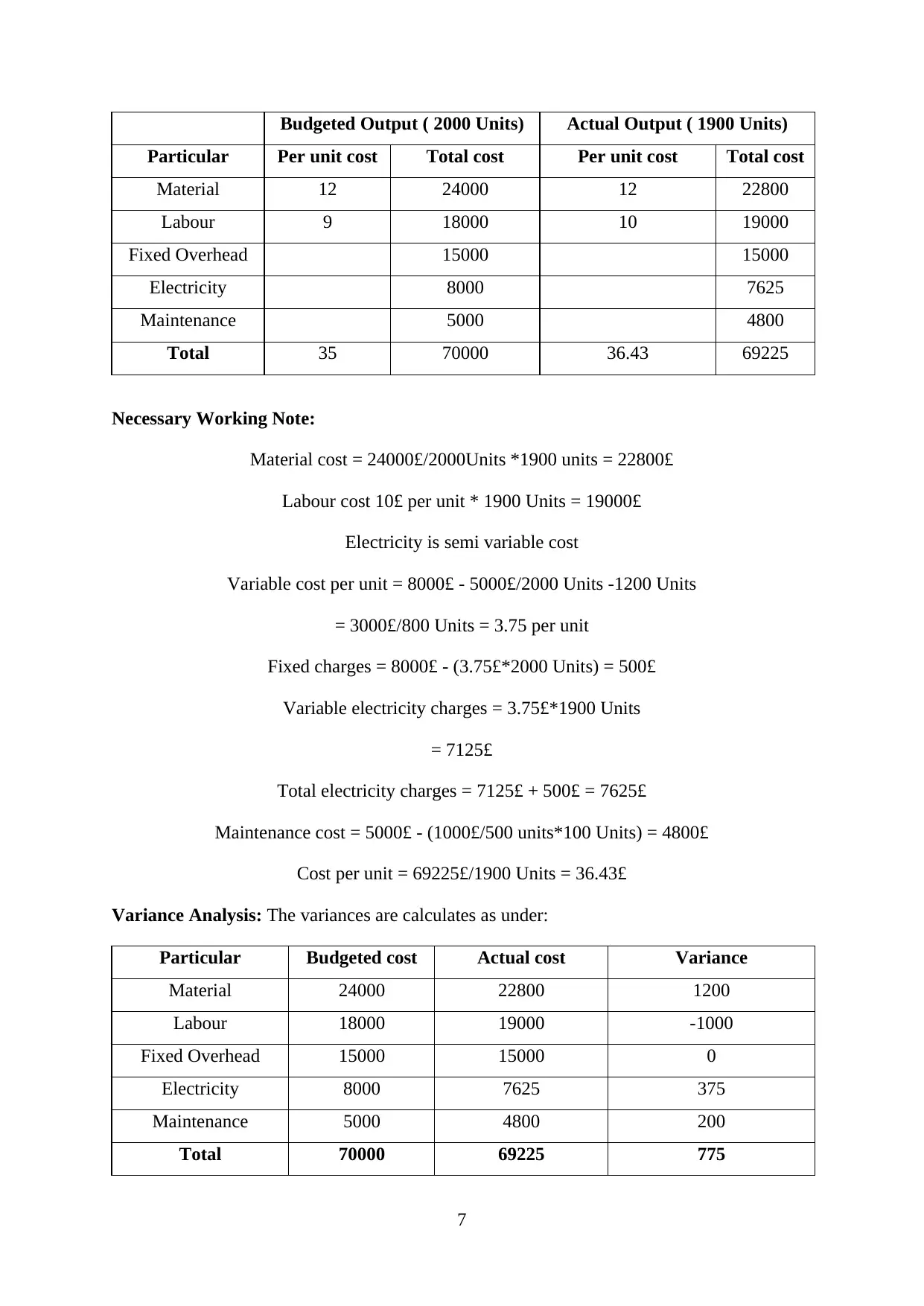
Budgeted Output ( 2000 Units) Actual Output ( 1900 Units)
Particular Per unit cost Total cost Per unit cost Total cost
Material 12 24000 12 22800
Labour 9 18000 10 19000
Fixed Overhead 15000 15000
Electricity 8000 7625
Maintenance 5000 4800
Total 35 70000 36.43 69225
Necessary Working Note:
Material cost = 24000£/2000Units *1900 units = 22800£
Labour cost 10£ per unit * 1900 Units = 19000£
Electricity is semi variable cost
Variable cost per unit = 8000£ - 5000£/2000 Units -1200 Units
= 3000£/800 Units = 3.75 per unit
Fixed charges = 8000£ - (3.75£*2000 Units) = 500£
Variable electricity charges = 3.75£*1900 Units
= 7125£
Total electricity charges = 7125£ + 500£ = 7625£
Maintenance cost = 5000£ - (1000£/500 units*100 Units) = 4800£
Cost per unit = 69225£/1900 Units = 36.43£
Variance Analysis: The variances are calculates as under:
Particular Budgeted cost Actual cost Variance
Material 24000 22800 1200
Labour 18000 19000 -1000
Fixed Overhead 15000 15000 0
Electricity 8000 7625 375
Maintenance 5000 4800 200
Total 70000 69225 775
7
Particular Per unit cost Total cost Per unit cost Total cost
Material 12 24000 12 22800
Labour 9 18000 10 19000
Fixed Overhead 15000 15000
Electricity 8000 7625
Maintenance 5000 4800
Total 35 70000 36.43 69225
Necessary Working Note:
Material cost = 24000£/2000Units *1900 units = 22800£
Labour cost 10£ per unit * 1900 Units = 19000£
Electricity is semi variable cost
Variable cost per unit = 8000£ - 5000£/2000 Units -1200 Units
= 3000£/800 Units = 3.75 per unit
Fixed charges = 8000£ - (3.75£*2000 Units) = 500£
Variable electricity charges = 3.75£*1900 Units
= 7125£
Total electricity charges = 7125£ + 500£ = 7625£
Maintenance cost = 5000£ - (1000£/500 units*100 Units) = 4800£
Cost per unit = 69225£/1900 Units = 36.43£
Variance Analysis: The variances are calculates as under:
Particular Budgeted cost Actual cost Variance
Material 24000 22800 1200
Labour 18000 19000 -1000
Fixed Overhead 15000 15000 0
Electricity 8000 7625 375
Maintenance 5000 4800 200
Total 70000 69225 775
7
⊘ This is a preview!⊘
Do you want full access?
Subscribe today to unlock all pages.

Trusted by 1+ million students worldwide
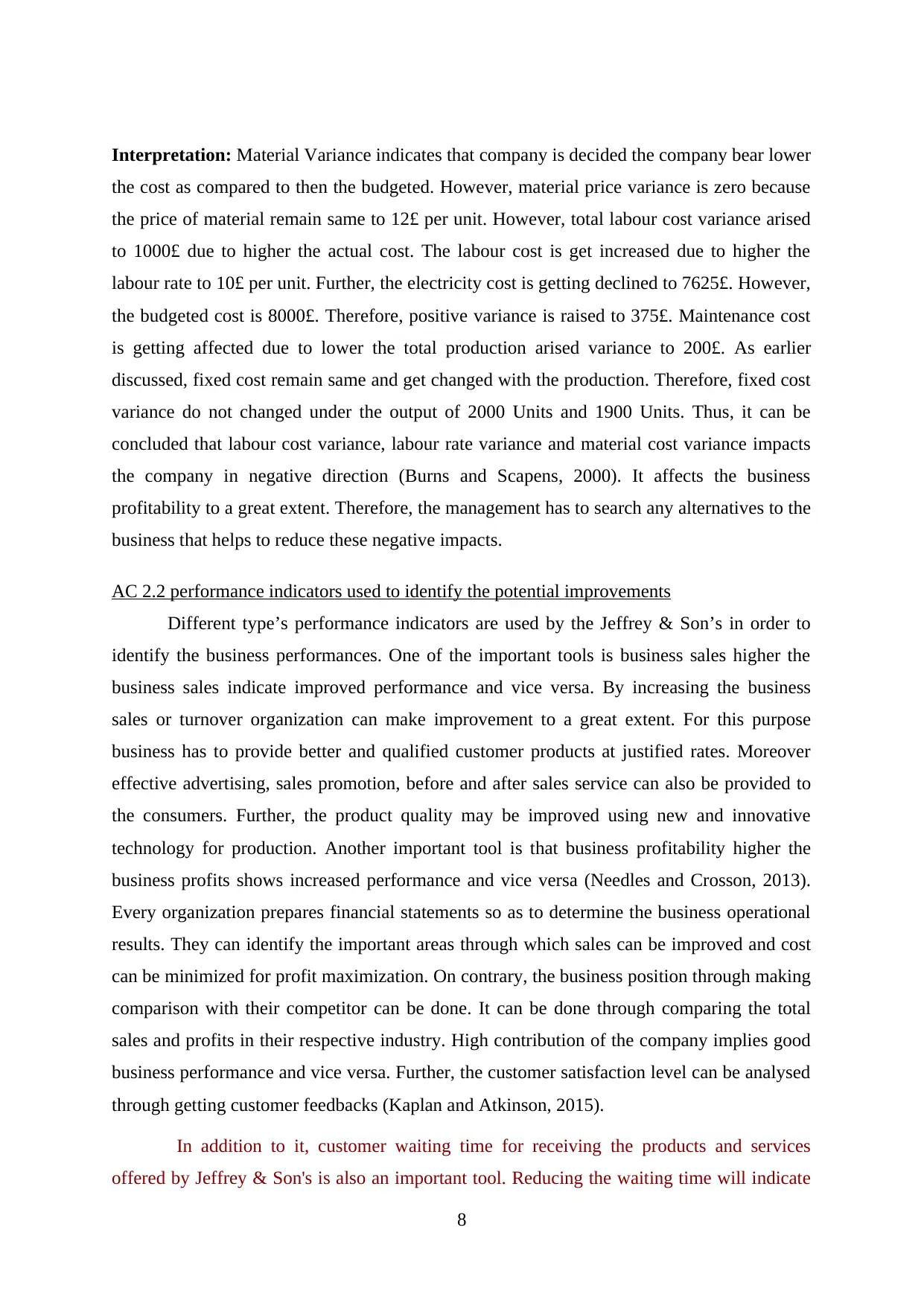
Interpretation: Material Variance indicates that company is decided the company bear lower
the cost as compared to then the budgeted. However, material price variance is zero because
the price of material remain same to 12£ per unit. However, total labour cost variance arised
to 1000£ due to higher the actual cost. The labour cost is get increased due to higher the
labour rate to 10£ per unit. Further, the electricity cost is getting declined to 7625£. However,
the budgeted cost is 8000£. Therefore, positive variance is raised to 375£. Maintenance cost
is getting affected due to lower the total production arised variance to 200£. As earlier
discussed, fixed cost remain same and get changed with the production. Therefore, fixed cost
variance do not changed under the output of 2000 Units and 1900 Units. Thus, it can be
concluded that labour cost variance, labour rate variance and material cost variance impacts
the company in negative direction (Burns and Scapens, 2000). It affects the business
profitability to a great extent. Therefore, the management has to search any alternatives to the
business that helps to reduce these negative impacts.
AC 2.2 performance indicators used to identify the potential improvements
Different type’s performance indicators are used by the Jeffrey & Son’s in order to
identify the business performances. One of the important tools is business sales higher the
business sales indicate improved performance and vice versa. By increasing the business
sales or turnover organization can make improvement to a great extent. For this purpose
business has to provide better and qualified customer products at justified rates. Moreover
effective advertising, sales promotion, before and after sales service can also be provided to
the consumers. Further, the product quality may be improved using new and innovative
technology for production. Another important tool is that business profitability higher the
business profits shows increased performance and vice versa (Needles and Crosson, 2013).
Every organization prepares financial statements so as to determine the business operational
results. They can identify the important areas through which sales can be improved and cost
can be minimized for profit maximization. On contrary, the business position through making
comparison with their competitor can be done. It can be done through comparing the total
sales and profits in their respective industry. High contribution of the company implies good
business performance and vice versa. Further, the customer satisfaction level can be analysed
through getting customer feedbacks (Kaplan and Atkinson, 2015).
In addition to it, customer waiting time for receiving the products and services
offered by Jeffrey & Son's is also an important tool. Reducing the waiting time will indicate
8
the cost as compared to then the budgeted. However, material price variance is zero because
the price of material remain same to 12£ per unit. However, total labour cost variance arised
to 1000£ due to higher the actual cost. The labour cost is get increased due to higher the
labour rate to 10£ per unit. Further, the electricity cost is getting declined to 7625£. However,
the budgeted cost is 8000£. Therefore, positive variance is raised to 375£. Maintenance cost
is getting affected due to lower the total production arised variance to 200£. As earlier
discussed, fixed cost remain same and get changed with the production. Therefore, fixed cost
variance do not changed under the output of 2000 Units and 1900 Units. Thus, it can be
concluded that labour cost variance, labour rate variance and material cost variance impacts
the company in negative direction (Burns and Scapens, 2000). It affects the business
profitability to a great extent. Therefore, the management has to search any alternatives to the
business that helps to reduce these negative impacts.
AC 2.2 performance indicators used to identify the potential improvements
Different type’s performance indicators are used by the Jeffrey & Son’s in order to
identify the business performances. One of the important tools is business sales higher the
business sales indicate improved performance and vice versa. By increasing the business
sales or turnover organization can make improvement to a great extent. For this purpose
business has to provide better and qualified customer products at justified rates. Moreover
effective advertising, sales promotion, before and after sales service can also be provided to
the consumers. Further, the product quality may be improved using new and innovative
technology for production. Another important tool is that business profitability higher the
business profits shows increased performance and vice versa (Needles and Crosson, 2013).
Every organization prepares financial statements so as to determine the business operational
results. They can identify the important areas through which sales can be improved and cost
can be minimized for profit maximization. On contrary, the business position through making
comparison with their competitor can be done. It can be done through comparing the total
sales and profits in their respective industry. High contribution of the company implies good
business performance and vice versa. Further, the customer satisfaction level can be analysed
through getting customer feedbacks (Kaplan and Atkinson, 2015).
In addition to it, customer waiting time for receiving the products and services
offered by Jeffrey & Son's is also an important tool. Reducing the waiting time will indicate
8
Paraphrase This Document
Need a fresh take? Get an instant paraphrase of this document with our AI Paraphraser
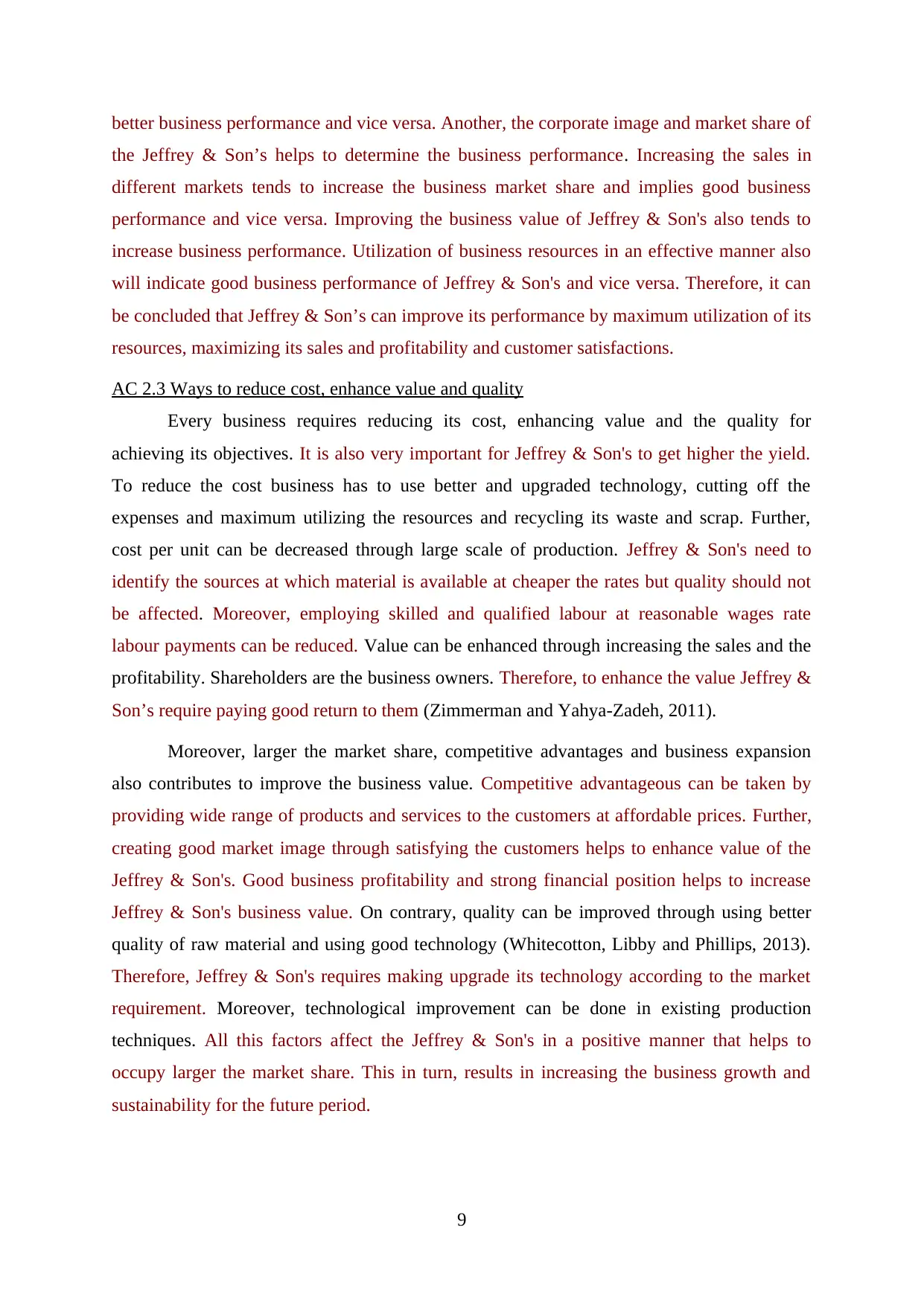
better business performance and vice versa. Another, the corporate image and market share of
the Jeffrey & Son’s helps to determine the business performance. Increasing the sales in
different markets tends to increase the business market share and implies good business
performance and vice versa. Improving the business value of Jeffrey & Son's also tends to
increase business performance. Utilization of business resources in an effective manner also
will indicate good business performance of Jeffrey & Son's and vice versa. Therefore, it can
be concluded that Jeffrey & Son’s can improve its performance by maximum utilization of its
resources, maximizing its sales and profitability and customer satisfactions.
AC 2.3 Ways to reduce cost, enhance value and quality
Every business requires reducing its cost, enhancing value and the quality for
achieving its objectives. It is also very important for Jeffrey & Son's to get higher the yield.
To reduce the cost business has to use better and upgraded technology, cutting off the
expenses and maximum utilizing the resources and recycling its waste and scrap. Further,
cost per unit can be decreased through large scale of production. Jeffrey & Son's need to
identify the sources at which material is available at cheaper the rates but quality should not
be affected. Moreover, employing skilled and qualified labour at reasonable wages rate
labour payments can be reduced. Value can be enhanced through increasing the sales and the
profitability. Shareholders are the business owners. Therefore, to enhance the value Jeffrey &
Son’s require paying good return to them (Zimmerman and Yahya-Zadeh, 2011).
Moreover, larger the market share, competitive advantages and business expansion
also contributes to improve the business value. Competitive advantageous can be taken by
providing wide range of products and services to the customers at affordable prices. Further,
creating good market image through satisfying the customers helps to enhance value of the
Jeffrey & Son's. Good business profitability and strong financial position helps to increase
Jeffrey & Son's business value. On contrary, quality can be improved through using better
quality of raw material and using good technology (Whitecotton, Libby and Phillips, 2013).
Therefore, Jeffrey & Son's requires making upgrade its technology according to the market
requirement. Moreover, technological improvement can be done in existing production
techniques. All this factors affect the Jeffrey & Son's in a positive manner that helps to
occupy larger the market share. This in turn, results in increasing the business growth and
sustainability for the future period.
9
the Jeffrey & Son’s helps to determine the business performance. Increasing the sales in
different markets tends to increase the business market share and implies good business
performance and vice versa. Improving the business value of Jeffrey & Son's also tends to
increase business performance. Utilization of business resources in an effective manner also
will indicate good business performance of Jeffrey & Son's and vice versa. Therefore, it can
be concluded that Jeffrey & Son’s can improve its performance by maximum utilization of its
resources, maximizing its sales and profitability and customer satisfactions.
AC 2.3 Ways to reduce cost, enhance value and quality
Every business requires reducing its cost, enhancing value and the quality for
achieving its objectives. It is also very important for Jeffrey & Son's to get higher the yield.
To reduce the cost business has to use better and upgraded technology, cutting off the
expenses and maximum utilizing the resources and recycling its waste and scrap. Further,
cost per unit can be decreased through large scale of production. Jeffrey & Son's need to
identify the sources at which material is available at cheaper the rates but quality should not
be affected. Moreover, employing skilled and qualified labour at reasonable wages rate
labour payments can be reduced. Value can be enhanced through increasing the sales and the
profitability. Shareholders are the business owners. Therefore, to enhance the value Jeffrey &
Son’s require paying good return to them (Zimmerman and Yahya-Zadeh, 2011).
Moreover, larger the market share, competitive advantages and business expansion
also contributes to improve the business value. Competitive advantageous can be taken by
providing wide range of products and services to the customers at affordable prices. Further,
creating good market image through satisfying the customers helps to enhance value of the
Jeffrey & Son's. Good business profitability and strong financial position helps to increase
Jeffrey & Son's business value. On contrary, quality can be improved through using better
quality of raw material and using good technology (Whitecotton, Libby and Phillips, 2013).
Therefore, Jeffrey & Son's requires making upgrade its technology according to the market
requirement. Moreover, technological improvement can be done in existing production
techniques. All this factors affect the Jeffrey & Son's in a positive manner that helps to
occupy larger the market share. This in turn, results in increasing the business growth and
sustainability for the future period.
9
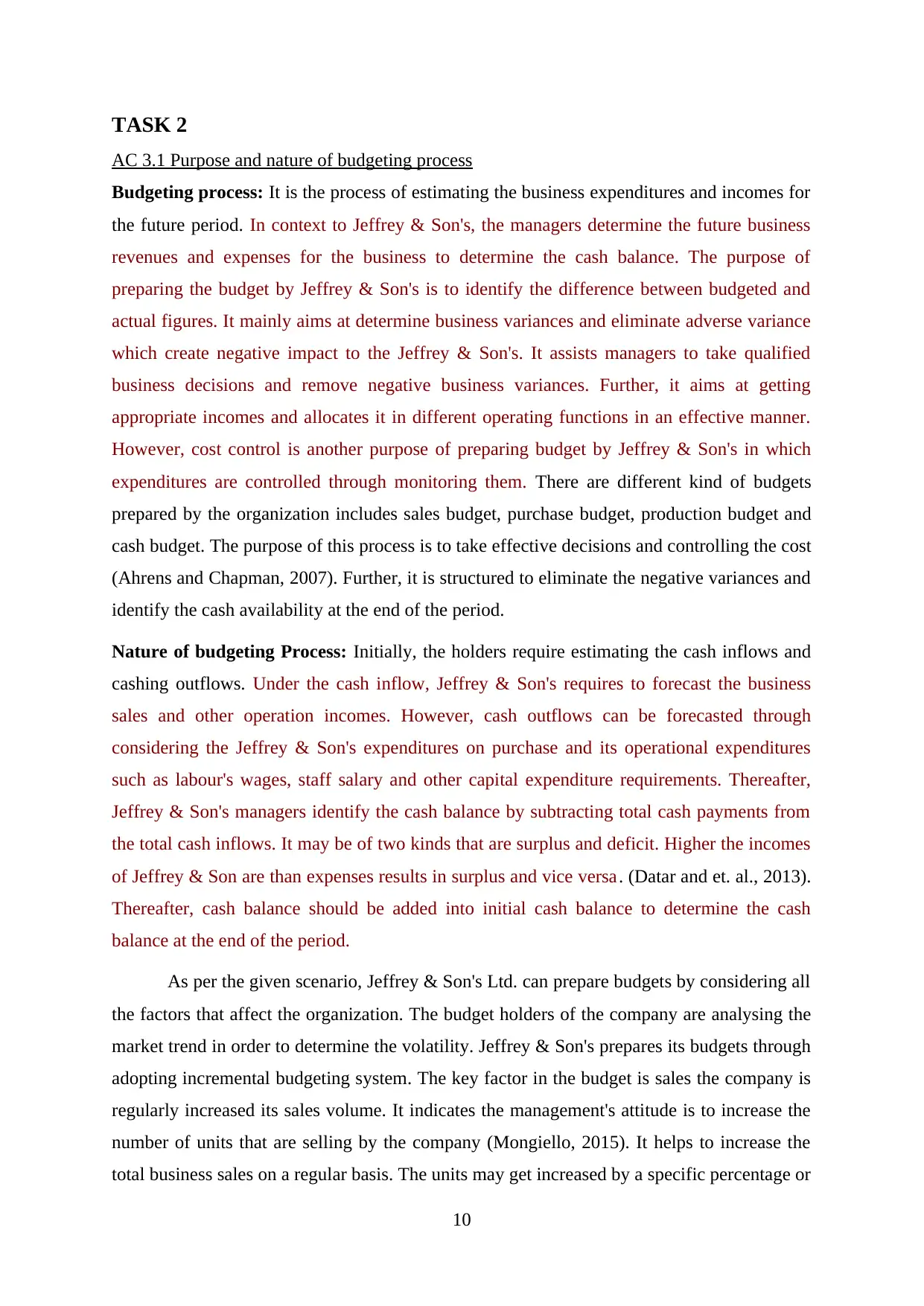
TASK 2
AC 3.1 Purpose and nature of budgeting process
Budgeting process: It is the process of estimating the business expenditures and incomes for
the future period. In context to Jeffrey & Son's, the managers determine the future business
revenues and expenses for the business to determine the cash balance. The purpose of
preparing the budget by Jeffrey & Son's is to identify the difference between budgeted and
actual figures. It mainly aims at determine business variances and eliminate adverse variance
which create negative impact to the Jeffrey & Son's. It assists managers to take qualified
business decisions and remove negative business variances. Further, it aims at getting
appropriate incomes and allocates it in different operating functions in an effective manner.
However, cost control is another purpose of preparing budget by Jeffrey & Son's in which
expenditures are controlled through monitoring them. There are different kind of budgets
prepared by the organization includes sales budget, purchase budget, production budget and
cash budget. The purpose of this process is to take effective decisions and controlling the cost
(Ahrens and Chapman, 2007). Further, it is structured to eliminate the negative variances and
identify the cash availability at the end of the period.
Nature of budgeting Process: Initially, the holders require estimating the cash inflows and
cashing outflows. Under the cash inflow, Jeffrey & Son's requires to forecast the business
sales and other operation incomes. However, cash outflows can be forecasted through
considering the Jeffrey & Son's expenditures on purchase and its operational expenditures
such as labour's wages, staff salary and other capital expenditure requirements. Thereafter,
Jeffrey & Son's managers identify the cash balance by subtracting total cash payments from
the total cash inflows. It may be of two kinds that are surplus and deficit. Higher the incomes
of Jeffrey & Son are than expenses results in surplus and vice versa. (Datar and et. al., 2013).
Thereafter, cash balance should be added into initial cash balance to determine the cash
balance at the end of the period.
As per the given scenario, Jeffrey & Son's Ltd. can prepare budgets by considering all
the factors that affect the organization. The budget holders of the company are analysing the
market trend in order to determine the volatility. Jeffrey & Son's prepares its budgets through
adopting incremental budgeting system. The key factor in the budget is sales the company is
regularly increased its sales volume. It indicates the management's attitude is to increase the
number of units that are selling by the company (Mongiello, 2015). It helps to increase the
total business sales on a regular basis. The units may get increased by a specific percentage or
10
AC 3.1 Purpose and nature of budgeting process
Budgeting process: It is the process of estimating the business expenditures and incomes for
the future period. In context to Jeffrey & Son's, the managers determine the future business
revenues and expenses for the business to determine the cash balance. The purpose of
preparing the budget by Jeffrey & Son's is to identify the difference between budgeted and
actual figures. It mainly aims at determine business variances and eliminate adverse variance
which create negative impact to the Jeffrey & Son's. It assists managers to take qualified
business decisions and remove negative business variances. Further, it aims at getting
appropriate incomes and allocates it in different operating functions in an effective manner.
However, cost control is another purpose of preparing budget by Jeffrey & Son's in which
expenditures are controlled through monitoring them. There are different kind of budgets
prepared by the organization includes sales budget, purchase budget, production budget and
cash budget. The purpose of this process is to take effective decisions and controlling the cost
(Ahrens and Chapman, 2007). Further, it is structured to eliminate the negative variances and
identify the cash availability at the end of the period.
Nature of budgeting Process: Initially, the holders require estimating the cash inflows and
cashing outflows. Under the cash inflow, Jeffrey & Son's requires to forecast the business
sales and other operation incomes. However, cash outflows can be forecasted through
considering the Jeffrey & Son's expenditures on purchase and its operational expenditures
such as labour's wages, staff salary and other capital expenditure requirements. Thereafter,
Jeffrey & Son's managers identify the cash balance by subtracting total cash payments from
the total cash inflows. It may be of two kinds that are surplus and deficit. Higher the incomes
of Jeffrey & Son are than expenses results in surplus and vice versa. (Datar and et. al., 2013).
Thereafter, cash balance should be added into initial cash balance to determine the cash
balance at the end of the period.
As per the given scenario, Jeffrey & Son's Ltd. can prepare budgets by considering all
the factors that affect the organization. The budget holders of the company are analysing the
market trend in order to determine the volatility. Jeffrey & Son's prepares its budgets through
adopting incremental budgeting system. The key factor in the budget is sales the company is
regularly increased its sales volume. It indicates the management's attitude is to increase the
number of units that are selling by the company (Mongiello, 2015). It helps to increase the
total business sales on a regular basis. The units may get increased by a specific percentage or
10
⊘ This is a preview!⊘
Do you want full access?
Subscribe today to unlock all pages.

Trusted by 1+ million students worldwide
1 out of 21
Related Documents
Your All-in-One AI-Powered Toolkit for Academic Success.
+13062052269
info@desklib.com
Available 24*7 on WhatsApp / Email
![[object Object]](/_next/static/media/star-bottom.7253800d.svg)
Unlock your academic potential
Copyright © 2020–2025 A2Z Services. All Rights Reserved. Developed and managed by ZUCOL.





